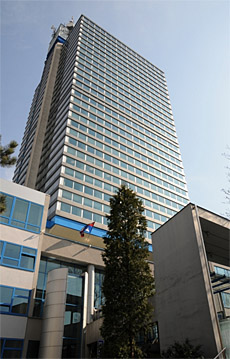
The highest Czech paternoster has been repaired
 |
The elevator, built in 1971, has only gone through a major renovation once, 25 years ago. Now, both gearboxes needed repair, and worn-out bearings had to be replaced in them. Langer does not know the cost of the repair.
"With its height of 56.8 m and 16 stations, the elevator has few competitors even in Europe," added Marie Filipová, head of the director's office. According to her, concerns that it would be abolished due to European Union regulations could be alleviated by its chances of being declared a technical monument.
The elevator consists of a system of 35 wooden cabins in a steel frame, suspended on two massive chain loops. It is powered by an electric motor through gearboxes. The cabins are designed for a maximum of two people and move at a constant speed of 0.3 meters per second, allowing for a safe boarding and alighting. The fully loaded elevator has a load capacity of 5,600 kilograms. The Liberec paternoster can transport up to 480 people from one boarding point in an hour. The device features sophisticated safety elements and reports any malfunction or stop acoustically. "The vertical guiding elements of the cabins in the elevator shaft are made of oak wood, which is permanently greased with grease. Therefore, the operation is almost silent," explained Langer.
The name was derived from the first words of the Latin version of the Lord's Prayer (Pater noster), as the elevator cabins move in a circle one after the other like beads on a rosary. According to Langer, using it daily is a pleasant experience. "Officials with documents briefly appear to their colleagues during the ride, greet them, and disappear in the direction of travel," he described.
The author of the building is architect Zdeněk Plesník, a designer from the 'gottwaldov' Centroprojekt. The building was not intended to be a solitary structure; it was supposed to be part of a complex of four-story buildings with a bridge over the Nisa River, which were never constructed. To this day, the bridging of the Nisa River, which flows just a few meters in front of the main entrance to the office, remains unresolved.
The English translation is powered by AI tool. Switch to Czech to view the original text source.
0 comments
add comment










